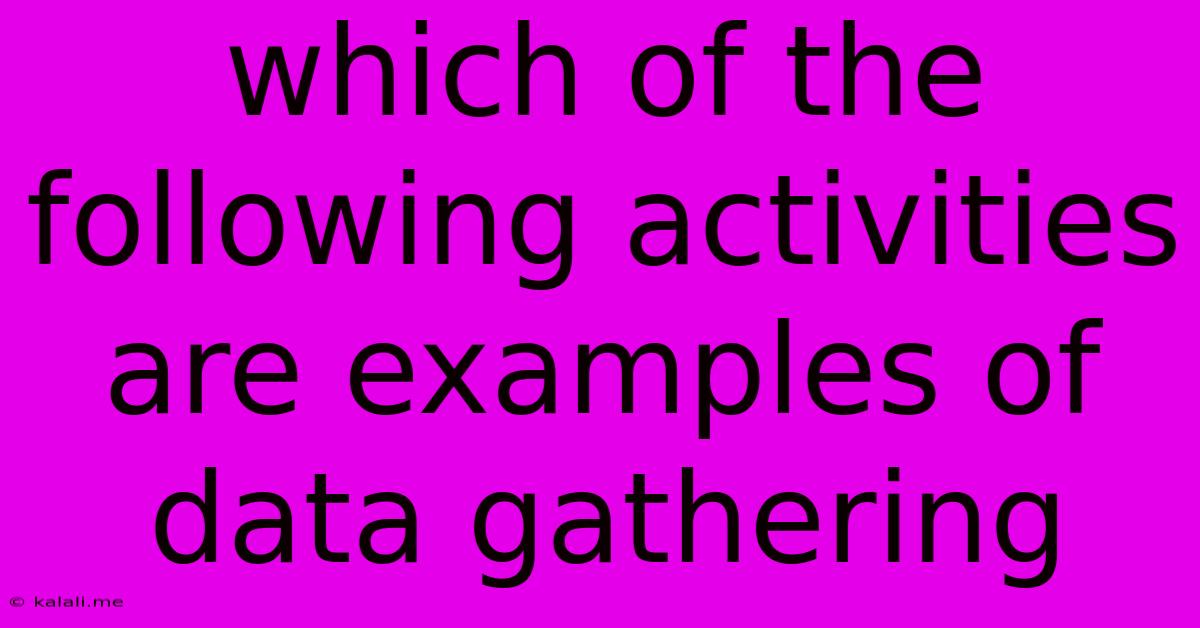Which Of The Following Activities Are Examples Of Data Gathering
Kalali
May 09, 2025 · 3 min read

Table of Contents
Which of the Following Activities Are Examples of Data Gathering? A Comprehensive Guide
Data gathering, also known as data collection, is a crucial first step in any research project, statistical analysis, or business intelligence initiative. It involves systematically collecting and measuring information on targeted variables in an established system, which then enables one to answer stated research questions, test hypotheses, or evaluate outcomes. Understanding what constitutes data gathering is essential for effective research and informed decision-making. This article will explore various activities and determine whether they fall under the umbrella of data gathering.
What is Data Gathering? Data gathering is the process of accumulating information from various sources. This information can take many forms, including numerical data (like sales figures or survey responses), textual data (like interview transcripts or social media posts), or visual data (like images or videos). The goal is to collect relevant and reliable data to answer specific questions or solve specific problems.
Examples of Data Gathering Activities:
Here are several activities, categorized to illustrate the breadth of data gathering methods:
1. Quantitative Data Gathering: This involves collecting numerical data that can be statistically analyzed.
- Surveys: Creating and distributing surveys (online, paper-based, or via phone) to gather responses from a target population is a primary example. Questions can be multiple-choice, Likert scale, or open-ended, yielding both quantitative and qualitative data.
- Experiments: Conducting controlled experiments to measure the impact of a variable on an outcome. This often involves collecting numerical data related to the experimental conditions and the results. Examples include A/B testing websites or clinical drug trials.
- Sensors and Automated Data Collection: Using sensors to automatically collect data on physical phenomena, such as temperature, pressure, or motion. This is common in IoT (Internet of Things) applications and environmental monitoring.
- Analyzing Existing Datasets: Accessing and analyzing existing datasets from government agencies, academic institutions, or commercial providers. This is often referred to as secondary data analysis.
2. Qualitative Data Gathering: This focuses on collecting descriptive information that provides insights into opinions, attitudes, and experiences.
- Interviews: Conducting structured, semi-structured, or unstructured interviews to gather in-depth information from individuals. This provides rich qualitative data that can be analyzed thematically or narratively.
- Focus Groups: Facilitating discussions with small groups of people to explore their perspectives on a particular topic. This method allows for the exploration of shared opinions and diverse viewpoints.
- Observations: Systematically observing behaviors and interactions in a natural setting. This is often used in ethnographic research and can generate rich qualitative data.
- Content Analysis: Analyzing existing text or visual data (e.g., social media posts, news articles, images) to identify patterns, themes, or opinions. This can be quantitative (e.g., counting the frequency of certain words) or qualitative (e.g., identifying recurring themes).
3. Activities that are NOT Data Gathering (or are a subset of it):
- Data Cleaning: This involves preparing the data for analysis by identifying and correcting errors, inconsistencies, or missing values. While crucial, data cleaning follows data gathering.
- Data Analysis: This refers to the process of inspecting, cleaning, transforming, and modeling data with the goal of discovering useful information, informing conclusions, and supporting decision-making. It's a post data gathering activity.
- Data Interpretation: Drawing meaningful conclusions and insights from analyzed data. This is the final stage of the research process, after data has been gathered and analyzed.
- Defining Research Questions: This is a preliminary step before data gathering. Clearly defined research questions guide the data collection process.
Conclusion:
Data gathering is a multifaceted process encompassing a wide array of methods and techniques. Understanding the differences between various data gathering approaches and related activities is critical for researchers, analysts, and anyone working with data. By employing appropriate methods and carefully considering the research question, you can collect reliable and meaningful data to support informed decision-making. Choosing the right method depends entirely on the research question, resources available, and the type of information sought. Remember that effective data gathering is the cornerstone of successful research and analysis.
Latest Posts
Latest Posts
-
What Is 450 Degrees Fahrenheit In Centigrade
May 09, 2025
-
27 Rounded To The Nearest Ten
May 09, 2025
-
What Percentage Is 50 Of 1000
May 09, 2025
-
How Much Is 64 Fluid Oz
May 09, 2025
-
Which Quadrilaterals Always Have Diagonals That Bisect Opposite Angles
May 09, 2025
Related Post
Thank you for visiting our website which covers about Which Of The Following Activities Are Examples Of Data Gathering . We hope the information provided has been useful to you. Feel free to contact us if you have any questions or need further assistance. See you next time and don't miss to bookmark.